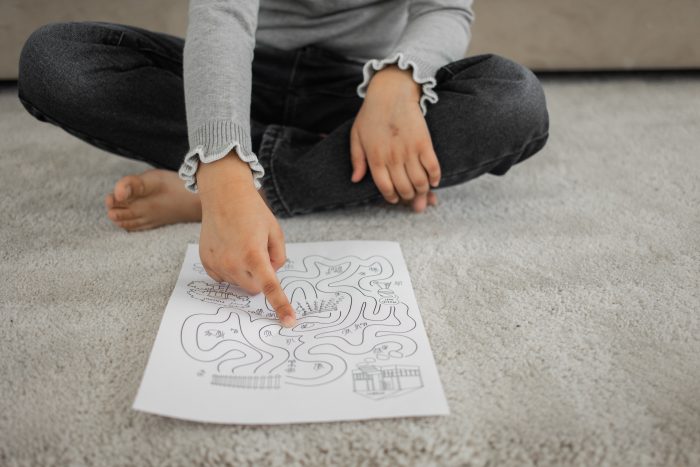Lily is a first-grader with an Intellectual Disability (ID).
The teacher is trying to get Lily to count to five on her fingers. Lily can count to four, but when she puts up the fifth finger, she says “Mama” and laughs. The teacher tells her to start over, and once again, Lily says, “One, two, three, four…”
“What comes next?” says the teacher.
“Mama!” says Lily happily.
A person with an intellectual disability usually has an IQ below 70 and significant limitations in two or more life skills. These limitations manifest before the person turns 22. Typically, they also have difficulties with emotional self-regulation, language, and behavior. When teaching children with ID, more repetitions may be needed for them to master a task. Abstract ideas have to be made concrete — with pictures or multisensory activities — like using playdough to roll out the letters in a word that is hard for them to read or spell.
Like Lily, they often perseverate or get stuck on a thought or activity. One of my former students, Riley, a boy with ID and radiantly pink cheeks, perseverated on princesses and Barbie dolls. Bringing his favorite Barbie to class or promising he could have it after he read a book or wrote a sentence was often the only way to get Riley to transition to the next activity or finish his schoolwork.
Like Riley, many children with ID are task avoidant. Because of low self-esteem and a fear of failure and criticism, they develop a repertoire of ways to avoid their schoolwork. Riley sometimes got angry and threw legos or messed up puzzles or scribbled on his paper. Sometimes he would run away or pound his fist on the desk, making frustrated “Erg!” noises. If he was very upset, sometimes he would pinch a teacher. Most of the time, however, he was a lovable and affectionate child who liked to put his head on my shoulder when I read to him.
How can mindfulness help children like Riley?
Mindfulness is paying attention to feelings, thoughts, and sensations in the present moment with kindness and curiosity. It has been shown to reduce stress and improve cognition. Teaching a simple practice called Meditation on the Soles of Your Feet has been shown to decrease aggressive behavior in children with ID and autism (see my article, “Meditating on their Feet Helps Calm Aggressive Kids” for more information).
But can children with ID be taught more than one mindfulness exercise? Yes, with adapted materials and instructions. A 2016 study looked at using mindfulness to address task-avoidance in three children with ID. During a daily arts activity, two trained observers collected data on task completion and task avoidant behavior. For example, were they focused on the task? Or were they out of their seat, tearing up their work, or kicking a desk?
After collecting baseline data, each child received 25 mindfulness sessions (45-minutes each). The first eight sessions were spent on understanding the basic concepts of awareness and attention: what does awareness mean? Becoming aware of our bodies is “to look at your body using your mind.” Over three days, children were trained to record what they observed. For example, on the first day, after listening to sounds in the environment, the children were encouraged to talk about what they were doing. “I was listening to birds singing.” Then they filled out a checklist about what they observed. On the second and third day, they were told to talk to themselves silently and then fill out a checklist. When they became accurate at recording their observations, they moved to the next step , saying, “I’m paying attention to…”
The next 10 sessions were spent paying attention to objects, their bodies, their feelings, and their thoughts. The last seven sessions focused on developing mindfulness of how they felt when given a task and how they could use mindfulness to manage their behavior.
After the intervention, two observers continued to watch on-and off-task behavior in the students for five days. Results showed that the children’s accuracy on math tasks improved and that they got faster at completing their work.
One way that this intervention was adapted for children with ID was by using expressive art supplies and activities (e.g., drawing, coloring, using playdough to make a sculpture, and making a collage) to help the children understand the content of the program. To teach awareness of sensations, the researchers used materials they thought the participants would find interesting — three kinds of Korean musical instruments, three kinds of herbal oils, and picture cues.
In a 2019 study with six adults with ID, the researchers made these changes to the traditional mindfulness intervention:
1. Adding this activity: washing hands mindfully with scented soap
2. Having a second practice meeting two days after each weekly session
3. Extending the traditional eight-week program to 11 weeks to allow more time for learning the program’s ideas
4. Using metaphors and similes to explain concepts like not getting on the “thought train…” or comparing frightening thoughts to monsters on a bus you are driving — can you keep driving toward your goal even though the monsters won’t sit down?
5. Encouraging participants to lead mindfulness practices so they could better internalize them
6. Drawing pictures at the end of each session
Here are some quotes from interviews with these adults after the program (grammar corrected to improve readability):
“Coz (because) when I’m on the bus if…I suffer from anxiety panic attacks…and what I do is if I feel an attack coming on, I just shut my eyes and just concentrate on my breathing…and it helps.” ~ Dean
“It’s helped with a big part of my life. It’s changed my life a bit because I used to be very stressed and I don’t care if my house is a mess, I’m not bothered anymore…I’ll tidy up…when I can get up and do it.” ~ Sharon
A 2022 study with 25 adults with ID found that six sessions of mindfulness training improved their Quality of Life — according to a survey that asked them questions like:
>> Do you have enough energy for everyday life?
>> How much do you enjoy life?
>> Have you enough money to meet your needs?
If you are a parent or teacher of adults or children with ID, I would love to hear from you.
Have you tried mindfulness training with them? If so, what techniques and strategies have you found to be successful?

 Share on bsky
Share on bsky







Read 1 comment and reply